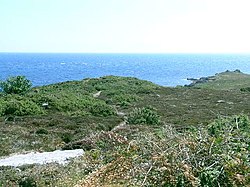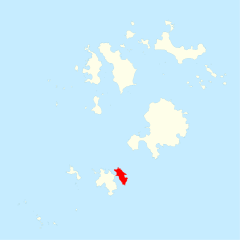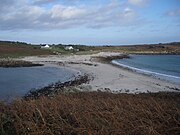Gugh
| Gugh Cornish: Keow | |
 Gugh landscape | |
|---|---|
| Location | |
| Grid reference: | SV890083 |
| Highest point: | Kittern Hill at 112 feet |
| Data | |
| Population: | 3 (2001) |
Gugh is an island of the Isles of Scilly, belonging to Cornwall. It could be described as the sixth inhabited island of the Isles of Scilly, but is usually included with St Agnes to which it is joined by a sandy tombolo known as "The Bar" when exposed at low tide. The island is somewhat less than a mile long and half of that in width, and at its highest point, Kittern Hill, it reaches 112 feet. Nevertheless, this small island is fascinating for the historical remains found on it, from the Stone Age to the Victorian.
The geology of the island consists of Hercynian granite with shallow podzolic soils on the higher ground and deeper sandy soils on the lower ground. The former Gugh farm is just north of the neck across the middle of the island between the two hills. The two houses were designed and built in the 1920s by a Mr Cooper.[1]
The island's name in Cornish was Keow, meaning "hedge banks".[2]
The island lies within the Isles of Scilly Heritage Coast, is in the Isles of Scilly Area of Outstanding Natural Beauty and is managed by the Isles of Scilly Wildlife Trust. Vegetation cover is mainly wind-pruned heath or dense bracken and bramble with a small area of coastal grassland formed over blown sand which has accumulated near the bar.
Contents
Historical remains
The earliest signs of occupation on Gugh are two groups, each, of entrance graves, and Bronze Age cairns. Entrance graves are either burial or ritual monuments and cairns are burial mounds. A lack of finds, most likely because of acid soils destroying any evidence, makes the dating of the monuments difficult but a few pottery remains date them to late Neolithic or early Bronze Age.
On Kittern Hill there are five entrance graves, one of which Obadiah's Barrow was excavated in 1900 and ″disarticulate unburnt bones″ found. There is also a cluster of fourteen cairns which are linked by prehistoric field walls or banks but the relationship between the two is not established.
The only menhir to be excavated on Scilly is the Old Man of Gugh, standing stone 9 feet tall which lies at the base of Kittern Hill, but there was no features or finds.
There is also a cluster of nineteen cairns and a field system on the south part of Gugh along with a further two entrance graves. A Civil War battery was built over one on Carn of Works and its chamber re-used as a magazine. The Civil War defences are concentrated around the Scillonian coast to defend the deep-water approaches.
Two kelp pits have been recognised, one on the north-east side of Kittern Hill and the second at Tol Tuppens. Burning seaweed was introduced in 1684 by Mr Nance on Teän to provide sodium carbonate for glass making and continued until 1835. Kelp burning only produces 2-3% sodium carbonate and during the 19th century more efficient commercial and industrial methods ended the practice locally.
Part of Gugh is a Scheduled Monument and the whole island is recommended for scheduling.[3]
Natural History
The island was first notified as a Site of Special Scientific Interest in 1976 and re-notified under the 1981 Act in 1986.
Flora
Much of the vegetation of Gugh is either wind-pruned, dry, waved maritime heath or dense gorse and bracken. The three dominant species on the heath are heather, bell heather and gorse. Immediately above the bar is a small area of dune grassland merging into maritime grassland around the coastal fringe. On the small dune system grows western clover, sea holly, sea spurge and Portland spurge, wild thyme (Thymus polytrichus) and sea bindweed.
The neck of the island between the two hills where the farm was has an unusual flora. Amongst dense bracken is balm-leaved figwort, common here but not found elsewhere on the island and an unidentified yellow, cultivated rose.
In October, 1972 a fire on Kittern Hill burnt though the shallow peaty soil to the granite. Bleached stones and blackened gorse stems can still be seen and the vegetation has not recovered sufficiently to equal the waved heath elsewhere on Scilly. Heath is on the hills on both sides of “the neck” and in the south of the island the nationally rare orange bird’s-foot can be found as can rare lichen species such as Lobaria pulmonaria and golden-hair lichen.[1]
Rare plants
- Shore dock (Rumex rupestris) first discovered here in 1893 by John Ralfs[4] still extant in the 1960s but now extinct
- Small adder's-tongue (Ophioglossum azoricum) has not been seen since at least the mid-1980s. The site was on the east coast between Carn Kimbra and Point Witcher.[1] The only area of the SSSI that was classified as "favourable".
- Four-leaved allseed (Polycarpon tetraphyllum) was recorded by Lousley in 1939 and 1940[5]
Birds and beasts
In July, 1924, W N Blair caught a shrew which he did not recognise and sent a specimen to the British Museum for the attention of Martin Hinton who identified it as the lesser white-toothed shrew (Crocidura suaveolens). Known as the "Scilly Shrew", the type specimen is held by the British Museum.[6]
The other mammals found on Gugh are feral cats, rabbit, the brown rat and possibly the house mouse.[7]
Rabbits are currently the only grazing animal and in the 1960s myxomatosis decimated the population and led to an increase of scrub on parts of the island, especially "the neck" where in some years cuckoos were attracted by the large numbers of garden tiger moth and other large caterpillars. In one year the number of garden tiger larvae was 90 every square yard! The last grazing animals left in 1974 and Natural England would like grazing animals back on Gugh to counteract the effects of the scrub and dense sward of grass covering parts of the island. A cobalt deficiency in the soil means grazing animals need supplements.[1]
In the southern part of the island large colonies of lesser-black-blacked and herring gull breed, as do a small number of greater black-backed gull. Manx shearwater, storm petrel and kittiwake no longer breed here.[1]
To protect and enhance the islands' seabirds and to protect Annet from re–invasion a feasibility study was carried out to see if it is possible to eradicate rats from the Isles of Scilly. A winter trapping survey on St Agnes and Gugh indicated that those islands had a population of 3300 brown rats. It was found the rats foraged on a variety of food including Scilly shrew which were found in the stomach contents of 18% of the rats trapped. Furthermore numbers of the shrew were higher in areas where the rats were controlled; an indication that rats are having an effect on their numbers. The survey showed that it was both feasible, and there are significant benefits, to remove the rats as they are preventing Manx shearwater and storm petrel from establishing on St Agnes and Gugh.
Rare birds
- A white-tailed eagle with a wingspan of 7' 6" was shot on the Gugh in November 1909.[7][8]
- A white-tailed eagle was seen on the Isles of Scilly (and Bosigran, Zennor) from April 1947 onwards. It was thought to roost on Gugh where it was once seen eating a shag.[9]
See also
Outside links
| ("Wikimedia Commons" has material about Gugh) |
- Lowland heathland - a cultural and endangered landscape
- Isles of Scilly Seabird Recovery Project: Frequently asked questions
- The Isles of Scilly Area of Outstanding Beauty
- The Isles of Scilly Wildlife Trust
- The Megalithic Portal article
References
- ↑ 1.0 1.1 1.2 1.3 1.4 Parslow, R. (2007) The Isles of Scilly. New Naturalist Library. London: Collins.
- ↑ Weatherhill, C. (2007) Cornish Place Names and Language. Ammanford: Sigma Press.
- ↑ Ratcliffe, J (1989). The Archaeology of Scilly. Truro: Cornwall Archaeological Unit.
- ↑ Marquand, E.D. (1893). Further records for the Scilly Isles. Journal of Botany 31: 267-7
- ↑ Lousley, J.E. (1971) The Flora of the Isles of Scilly Newton Abbot: David & Charles
- ↑ Blair, W. N. (1926) Blair's White-toothed Shrew. Scillonian 5:164-5.
- ↑ 7.0 7.1 Robinson, P. (2003) The Birds of the Isles of Scilly. London: Christopher Helm.
- ↑ (Letter, Clark to King, 25.x.1923) In Penhallurick R.D. (1978) The Birds of Cornwall and the Isles of Scilly. Penzance: Headland Publications.
- ↑ Penhallurick R.D. (1978) The Birds of Cornwall and the Isles of Scilly. Penzance: Headland Publications.
| Isles of Scilly |
|---|
|
St Mary's •
St Agnes •
Tresco •
Bryher •
St Martin's •
Gugh
|

